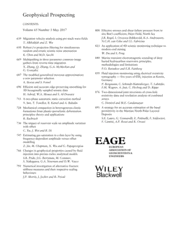
Full text loading...
The possibility of a time‐domain electromagnetic sounding method using excitation and measurement of vertical electric fields to search for and identify deeply buried reservoirs of hydrocarbons offshore is investigated. The method operates on source–receiver offsets, which are several times less than the depth of the reservoir. Geoelectric information is obtained from the transient responses recorded in the pauses between the pulses of electric current in the absence of the source field. The basics of the method, as well as its sensitivity, resolution, and the highest accessible depth of soundings for various geological conditions in a wide range of sea depths, are analyzed. For the analysis, 1D and 3D geoelectric models of hydrocarbon reservoirs are used. It is shown that under existing technologies of excitation and measurement of vertical electric fields, the highest accessible depth of soundings can be up to 4 km. Technology for the inversion and interpretation of transient responses is demonstrated on experimental data.

Article metrics loading...

Full text loading...
References


Data & Media loading...

